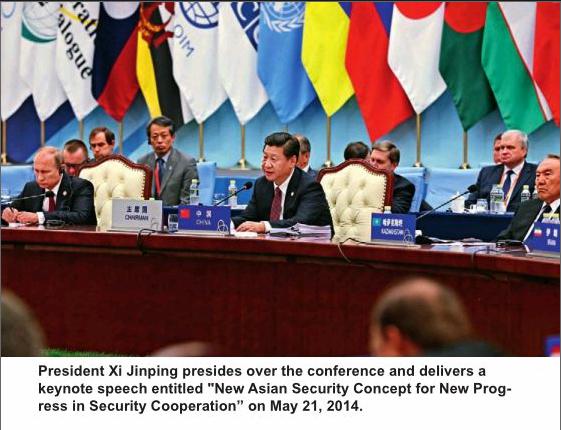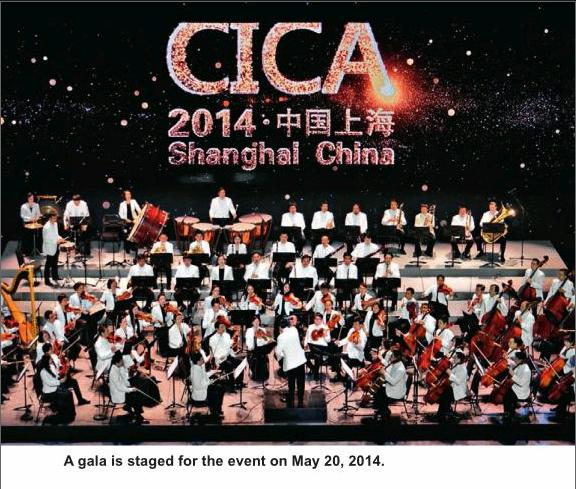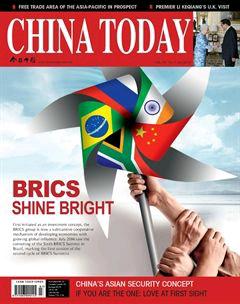China’s Asian Security Concept
By+LIU+JIANCHAO


PARTICIPANTS in the Fourth Summit of the Conference on Interaction and Confidence Building Measures in Asia (CICA), hosted for the first time by China from May 20 to 21, were the most ever in the events 15-year history.
China promoted at the summit the establishment of a new Asian security concept among various countries, and discussed with participants a new framework for regional security and cooperation.
The 21st century, defined by multi-polarization and globalization, must abandon old security concepts associated with hegemony, power politics and military supremacy and instead embrace those of mutual trust, mutual benefit, equality and coordination. All parties concerned should promote security that is common, comprehensive, cooperative, and sustainable.
Equality based on a foundation of development is vital to sustainable security. Only through mutual respect and equality can conflicts and frictions between countries be alleviated and peace and stability achieved.
Cold War ideology should be considered a “fossil” of 20th-century international relations that belongs in a museum. Asian countries should consider their neighbors as friends rather than rivals, and depend upon political mutual trust to defend their community of common destiny.
We must strengthen and make optimum use of the Shanghai Cooperation Organization (SCO), CICA, ASEAN Regional Forum and other existing regional security dialogue and cooperation mechanisms. We must also formulate and establish such a mechanism in Northeast Asia, and promote conventional and unconventional cooperation to enhance regional security. Communication and exchanges between different mechanisms must also be strengthened to the extent where they supplement and support each other through pooling forces to safeguard regional security.
An advocate and practitioner of the new Asian security concept, China joins other nations in creating an environment in Asia conducive to peace, development, cooperation, and win-win.
Peaceful Development
Adhering as it does to the path of peaceful development that radiates from neighborly ties and cooperation and leads to common benefit, China urges other countries to do likewise. Sixty years ago, China, India, and Myanmar jointly raised the five principles of peaceful coexistence that have since evolved into a fundamental guiding tenet of international relations. In 2013 China proposed amity, sincerity, mutual benefit, and inclusiveness as the underlying ideas and motivations shaping its foreign policy. China was also the first non-ASEAN country to join the Treaty of Amity and Cooperation in Southeast Asia, and the first major country to establish a strategic partnership with ASEAN. China is moreover among the first to proffer help and humanitarian aid to countries that have suffered natural disasters.
China is committed to solving territorial disputes, either on land or sea, through friendly negotiations and other peaceful means. It accords with the Declaration on the Conduct of Parties in the South China Sea, and has been active in formulating the Code of Conduct in the South China Sea. China has proposed shelving disputes and codeveloping resources until disputes in the region are resolved. China has also earmarked RMB 3 billion to set up the China-ASEAN Maritime Cooperation Fund. All of this testifies to Chinas resolve to make the sea a bond of friend- ship between Asian countries. China meanwhile steadfastly safeguards national sovereignty, security, and interests. Although never provocative, China will meet any challenge to its principles and bottom line, and never yield to external pressure or submit on matters of national core interest.
Win-win Results
A staunch advocate of cooperation, mutual benefit, and win-win, China is committed to promoting common prosperity in Asia through its own development.
China and ASEAN have built the worlds largest free trade zone among developing economies. Their bilateral trade grew at an average annual rate of 23.6 percent in the decade 2002 to 2012, and mutual investments accrued 3.4-fold. In 2012, Chinas overseas investment in Asias non-financial sectors approached US $55 billion, accounting for more than 70 percent of the countrys total outbound investment. China is both the largest trade partner and main source of capital of most Asian countries. Its trade with South Korea, for instance, exceeds that between South Korea, the U.S. and Japan combined. Since last year China has raised several proposals on regional cooperation, such as the Silk Road Economic Belt, the 21st Century Maritime Silk Road, Asian Infrastructure Investment Bank and an upgraded version of the ASEAN-China FTA. All are expected to promote development in Asia.
As China comprehensively deepens reforms and proceeds with economic restructuring, its contributions to neighboring countries and world economic growth will expand. In the coming five years, China will import US$10 trillion worth of commodities, and lay out US $500 billion on overseas investment. Chinese people will also make an estimated 500 million international trips. Mean-while, by the year 2020 China is expected to top world consumption, which implies enormous opportunities for other Asian countries.
Sino-U.S. Cooperation Promotes Asian Security
China and the U.S. are formulating a new-type relationship between major countries that is expected to energize Asian peace and stability. Chinese President Xi Jinping and U.S. President Barack Obama reiterated in March at the Nuclear Security Summit in The Hague the two countries commitment to a new type of major-country relationship that features non-confrontation, nonconflict, mutual respect, and win-win cooperation. Asia constitutes the highest density of interwoven China-U. S. interests, and is where their interactions are most frequent. Construction of a new type major-country relationship between the two countries should start in this region.
Chinese and U.S. interests are profoundly interrelated. The two countries have worked closely together in handling unconventional security threats and global challenges. Respecting as it does the traditional influence and pragmatic interests of the U.S. in Asia, China has no intention of elbowing it out of the region. Similarly, it expects the U.S. to respect Chinas interests and concerns, and to be proactive and constructive in safeguarding peace and stability in the Asia-Pacific. As long as the two parties remain cognizant of one anothers reasonable interests and concerns and accordingly expand the intersection of their common interests, appropriately handling any disputes that arise, they can maintain steady development of bilateral ties.
China-U.S. coordination and cooperation on regional affairs is improving. What were formerly sticking points are becoming highlights of cooperation and growth points of mutual trust, all of which bodes well for regional peace and stability. More and more countries in Asia welcome China-U.S. cooperation. Any attempt to reap selfish gains from conflicts between the two countries runs counter to the global trend. A cooperative system in Asia is one that must be open and inclusive.
This year marks the 35th anniversary of full diplomatic relations between China and the U.S. Chinese tradition holds that a person attains full independence and maturity at the age of 30. We hence have reason to believe that China-U.S. relations will mature and become even more stable; also that the envisioned new-type major-country relationship will revitalize their cooperation and contribute to peace in Asia and throughout the world.
Asian Security Mechanisms
A key participant in construction of the Asian security mechanism, China has, as a major country in the region, honored its obligations with respect to hot issues.
Compared with the brisk progress of economic cooperation among Asian countries, development of security mechanism has been sluggish. More complicated challenges to regional security brook no further delay in this regard.
China is a proactive participant in existing multilateral Asian security cooperation mechanisms. It supports ASEANs central role in regional cooperation and also helps to advance multilateral regional security cooperation with ASEAN at the core. China works jointly with other Shanghai Cooperation Organization members to combat the three evil forces of terrorism, extremism, and separatism, and to safeguard peace and stability in Central Asia. In the search for Malaysia Airlines flight MH370 China acted promptly and at full throttle, working closely with other countries involved. The incident underlines the significance and pressing need to enhance regional security cooperation mechanisms.
China is committed to the pursuit of peaceful solutions to regional hot issues. We are steadfast in promoting denuclearization of the Korean Peninsula, and urge all parties concerned to move in the same direction. With the nuclear issue of North Korea back on the negotiation table, the six-party talks may then resume. China is also involved in the peace process and reconstruction of Afghanistan. It will host later this year the Fourth Foreign Ministers Conference of the Istanbul Process on Afghanistan. It is hoped that all parties concerned will reach a consensus and pool efforts to help the war-plagued country through political, economic and security transition that leads to lasting peace.
History offers lessons for the future. Asias remarkable achievements over past years are largely accredited to the peace and stability in the region which are also critical to its future development.

